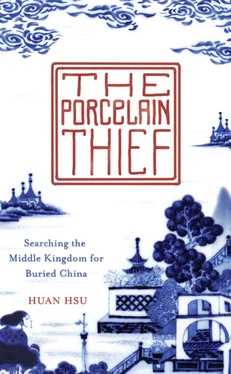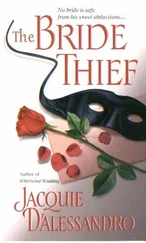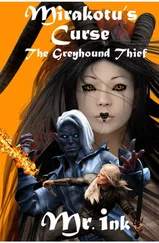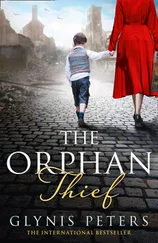The first thing Andrew said to me was “That long hair makes it seem like you’re hiding something, like a physical deformity.”
The second thing he said was “The sun has aged you. You look way older than your age.”
We headed for the company living quarters in Zhangjiang, a district on the eastern outskirts of Shanghai, driving along a massive, well-lit, desolate freeway. Andrew had offered to let me stay in a spare room of his three-bedroom apartment in exchange for paying the utilities and the salary of the maid, or ayi —literally “auntie”—who came to clean three times a week. As we neared the living quarters, our route took us past the new church that our uncle had recently built, a cavernous glass-and-metal A-frame looming in the hazy glow of the streetlight, and I remarked that I had not seen it during my brief visit to the city three years earlier.
“We build things fast in Shanghai,” the driver said.
“They seem to build things fast in all of China,” I tried to say in Chinese, shaking my head.
I must have said something wrong, as the driver got defensive. “Yes, but we build things even faster in Shanghai,” she said. She also mentioned that the church had been closed for a while due to structural concerns, as if the two observations were completely unrelated.
THE SUN ROSE EARLY and hot over the living quarters, a seventy-acre complex abutting a technology park on the edge of Shanghai’s eastward urbanization as it churned through estuaries, villages, and farmland and left housing complexes, industrial parks, and manufacturing facilities in its wake. I didn’t start work for another week and wanted to buy a voice recorder for when I talked to my grandmother, so Andrew took the day off and we headed into the city for one of Shanghai’s massive electronics shopping malls.
The living quarters in Zhangjiang housed nearly six thousand employees and their families on a landscaped campus divided by one of the area’s many canals. Every day elderly men set up along it with bamboo fishing rods curving over the water. On one side rose about sixty high-rise apartment buildings along with a health clinic, guest housing for visitors, an administrative center (including a control room for monitoring the video feeds from the dozens of closed-circuit cameras trained on the walkways), and three dormitories for the machine assistants, or MAs, largely young, single women with basic educations from rural provinces who worked in the fab, moving items from one step of the manufacturing process to the next. On the other side of the canal, accessed by a small footbridge or a separate guarded entrance, was the executive housing, a gated community of about fifty villas with private yards and two rows of townhouses. Camphor trees shaded the walkways, and in the fall the pomelo trees near the playground sagged with fruit, tempting residents to climb up or fashion makeshift pickers to get at them.
Across the street from the residential campus was one of the company’s crown jewels, a bilingual K-through-12 private school headed by a former dean of Phillips Andover, and boasting all the facilities that a counterpart in America might have offered: a gymnasium with basketball and volleyball courts, a full-size running track, soccer fields that were repurposed into Little League baseball diamonds on the weekends, even an observatory. Flanking the school was a community center where employees and their families could work out, play Ping-Pong, take classes, or swim in the Olympic-size pool, and a commercial strip of stores, beauty salons, and a rotating array of eateries. Two small supermarkets sold fresh fruits and vegetables, scary-looking meats, and a handful of imported goods, like peanut butter and grossly overpriced Häagen-Dazs ice cream. People in the surrounding farming villages still burned their garbage, and when the wind shifted, the smoke blew right into the living quarters.
A multicolored line of taxis waited outside the main gate. Andrew explained that each taxi company painted its fleet a different color, and we caught a sky-blue Volkswagen sedan; Andrew had noticed that its drivers tended to be the best, denoted by the stars printed on their licenses, though I later learned that those, like many, many other things in China, could be bought. The taxi ferried us to the nearest subway station, on the other side of the technology park, its wide, empty boulevards named after famous scientists in Chinese history and the cross streets named for Western scientists. Some blocks were more than a quarter of a mile long to accommodate the massive manufacturing facilities headquartered there, our uncle’s being one of the largest. Street sweepers wearing sandals and reflective orange jumpsuits collected litter with handmade brooms and rickety carts at a languid pace. Many others dozed on the landscaped corners and medians, sprawled out as if dead.
After about three miles the taxi dropped us off at the Zhangjiang Hi-Technology Park metro station, an elevated monstrosity of concrete and dirty white tiles strewn with garbage and vomit and crowded with vendors selling street food and pirated DVDs (“Porn, porn,” one of them whispered to me as I walked past) and taxi touts angling for fares. The train zipped us over villages where small farm plots sat beside enormous, ever-growing mounds of trash, then dived underground as we approached the Huangpu River. Each time the train pulled into a station, passengers massed on both sides of the doors and charged forward as soon as the doors opened, crashing into and off of each other until both groups somehow osmosed to the other side. Despite stationing attendants at the turnstiles wearing signs to be polite, stand in line, wait one’s turn, and generally “be a cute Shanghai person,” the Western idea of civility was all but absent in the subways. While riding public transportation, or in public spaces in general, the Chinese had the same sense of personal space as puppies, often literally piled on top of one another. On escalators they stood on whichever side pleased them. They stuffed elevator cars so tightly I wasn’t sure everyone had their feet on the ground, and would often ride opposite their desired direction of travel just to ensure they got a space. Occasionally, on the less crowded trains, young men with spiky, chocolate-colored hair holding stacks of business cards advertising travel agencies would stride the length of the train and fling the cards onto the passengers, hitting each person’s lap with the accuracy of a casino dealer. I found this kind of guerrilla marketing obnoxious, but the Chinese riders never objected, brushing off the card as they would a stray hair.
After thirty minutes we arrived at the East Nanjing Road station in the heart of the city. It was a bit of a stretch to call the place where I would be living and working Shanghai. Situated at the mouth of the Yangtze River and bisected by a tributary called the Huangpu River, Shanghai consists of two sections, Puxi, literally “west bank of the [Huangpu] river,” and Pudong, “east bank of the [Huangpu] river.” Historically, Puxi had been the city’s cultural, economic, and residential center, and home to the nineteenth-century colonial concessions that included the Bund, the mile-long stretch along the river where Western architects had erected dozens of impressive consulates, bank buildings, and trading houses, a concentration of international financial and commercial institutions that made the Bund the Wall Street of Asia. In the middle of the Bund, straddling the east–west thoroughfare of East Nanjing Road, real estate magnate Victor Sassoon built a pair of hotels in the early 1900s. From the subway station, the pyramidal art deco top of the north building, dubbed the Peace Hotel, which was closed for a three-year-long renovation, loomed like a hilltop citadel. At the Bund’s north end is the oldest park in Shanghai, built in the late nineteenth century for the city’s affluent and growing foreign population, where, according to legend, a sign proclaimed “No Chinese or Dogs Allowed.” (No such sign existed, but the park did prohibit locals and pets.) The Bund remains the most desirable real estate in town, and the colonial-era buildings have been recolonized by luxury brand boutiques, art galleries, and five-star restaurants.
Читать дальше












